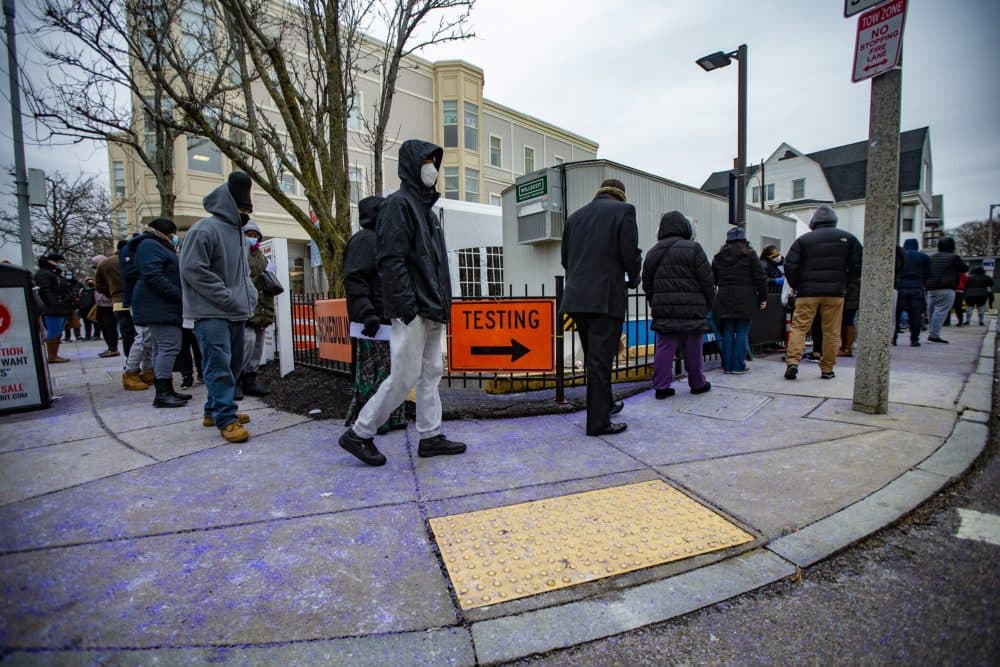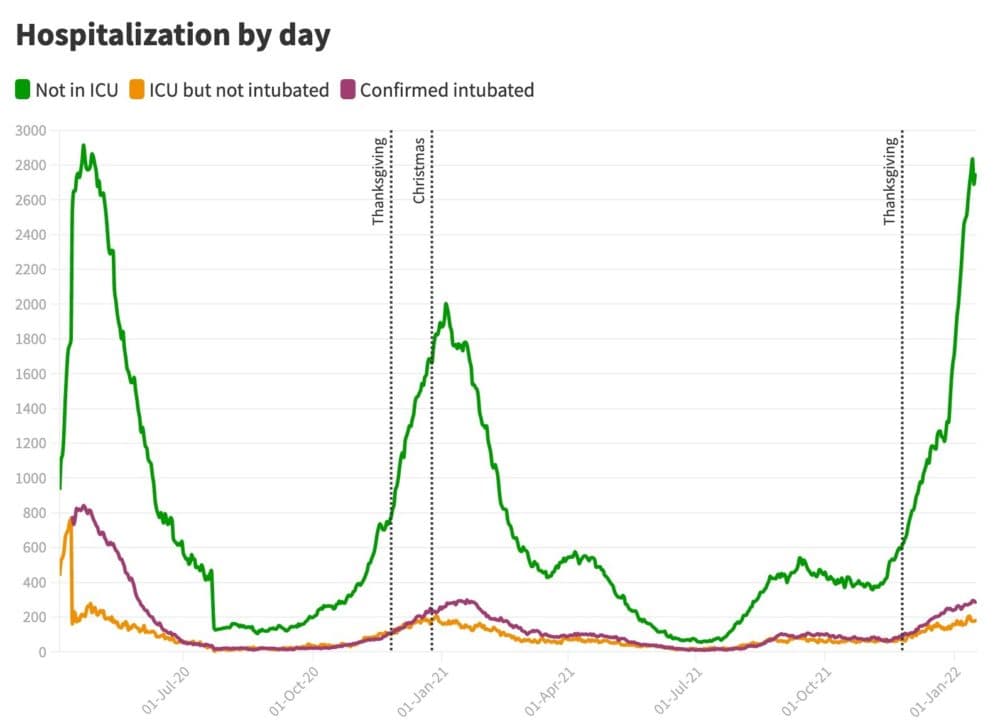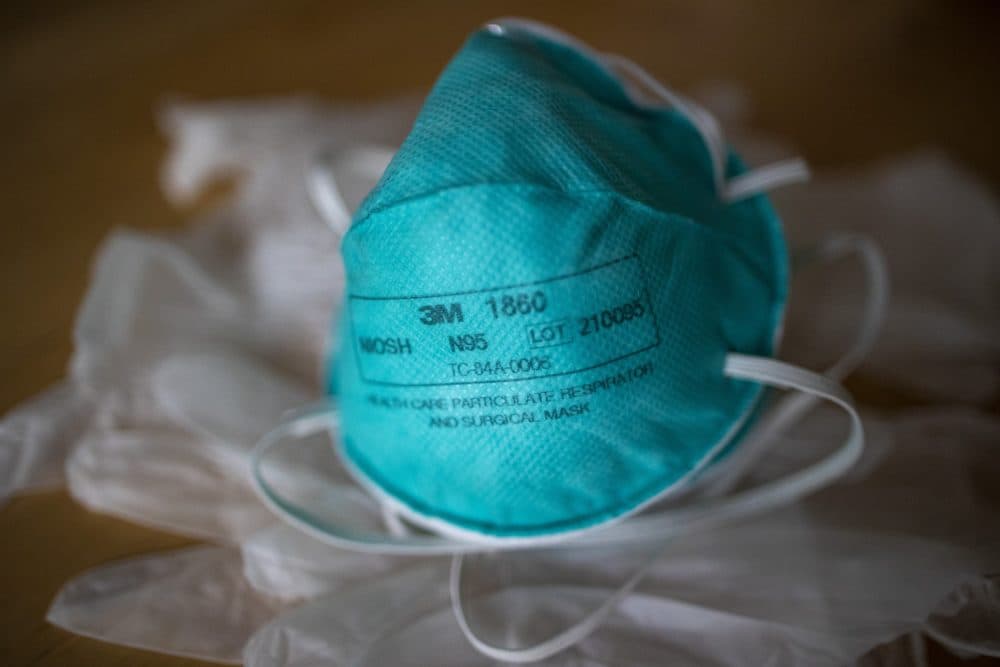Advertisement
Coronavirus Coverage
Epidemiologists warn impacts of omicron could linger 'if you declare victory too quickly'

Official case counts are dropping. COVID levels in Boston-area wastewater are down dramatically. The omicron wave — in terms of new cases — appears to have peaked in Massachusetts. And experts say hospitalizations are likely nearing or at their peak, too. But some epidemiologists are urging caution and pointing out that cases remain far above previous surges, and hospitals are still overwhelmed.
“Epidemics are symmetrical: just as many people get infected on the downside as the upside,” said Justin Lessler, an epidemiologist at the University of North Carolina and part of the COVID-19 Scenario Modeling Hub.
Here is a look at where the state stands in the omicron wave, when epidemiologists say it’s time to begin relaxing precautions and what needs to happen once omicron is in the rearview mirror.
Where Are We In The Omicron Wave?
“The rate of increase in numbers of cases was spectacular in the Massachusetts area and the Northeast — the way that it was in South Africa and in the U.K. — and it seems to be declining at a similarly spectacular rate,” said Jeremy Luban, professor of biochemistry and molecular pharmacology at UMass Chan Medical School.
The amount of virus circulating peaked and started coming down sometime in the first week of January, based on sewage measurements taken in the Boston-area. Hospitalizations may be peaking too, but they tend to lag cases by two or three weeks, experts say. Deaths have not yet peaked, although it’s still unclear how high this grim measure might go given the high vaccination rate in Massachusetts and the evidence that omicron seems to cause less severe illness.

“The real question now is how fast things are going to come down,” said Samuel Scarpino, managing director of pathogen surveillance at the Rockefeller Foundation. “It may be that the tail is much longer than we might anticipate.”
Scarpino points to cases in South Africa, which are declining but at a slower rate than before.
How Quickly Will Omicron-Related Disruptions Subside?
From schools to hospitals to the airline industry, omicron has been the cause of various closures, shortages and delays.
“Something this transmissible is damaging just because it's transmissible, because it sows chaos. It means that suddenly half of your workforce is out sick, and the other half are having to quarantine,” said William Hanage, an epidemiologist and co-director of the Center for Communicable Disease Dynamics at Harvard’s T.H. Chan School of Public Health. “What this suggests is that particular period may be over.”
However, the situation is still dire when it comes to health care shortages and hospital capacity.
“It's really difficult to get an ambulance in some settings. It's really difficult to get a hospital bed,” said Andrea Ciaranello, director of the Perinatal Infectious Disease Program at Massachusetts General Hospital. “We're going to see a lot of really preventable illness and death.”
Advertisement
Scarpino estimates that the consequences of the omicron variant for health care are likely to last a month or so after the peak in cases.
When Can We Relax Precautions?
We are all weighing the cost of heightened precautions against the spread of COVID with the costs of isolation and disrupted daily activities. While acknowledging exhaustion with pandemic measures, many experts are urging people to remain cautious at least until hospitalizations reach a low level. They say just a couple more weeks could make a big difference.
“If you declare victory too quickly after the peak, the cases will just go back up again,” said Scarpino. “What's going to be really important is we keep measures in place until we get the hospitalization numbers back down and that we're very cautious as we start to reopen.”
If people who have voluntarily hunkered down during the remarkable rise in omicron cases resume regular activities, Scarpino said, we could see mini-waves or case levels smoothing out at a high level.
“As we enter March, the projections we've seen have cases going down a lot,” said Lessler, of the COVID-19 Scenario Modeling Hub. “We're probably not going to get to the [low] levels we were seeing last summer until later in the spring.”
Will There Be Another Variant After Omicron? If So, How Do We Prepare?
Epidemiologists and forecasters uniformly say: Yes, there will be another COVID variant coming.
“We know this is going to happen again,” said Scarpino. “As we exit from this surge, which we will, we need to invest in the future.”
Scarpino and others are urging individuals, institutions and governments to use the intervening time between surges to prepare.
They want to see people up their mask game, obtaining and wearing only high-filtration masks, such as N95, KN95 or KF94. Cloth masks, and even surgical masks, are not sufficient protection anymore, Scarpino said.

He’d also like to see investments in building ventilation. It’d be a mammoth undertaking, Scarpino acknowledged, on a par with Europe in the 1800s when governments invested in sanitation infrastructure following cholera outbreaks.
Others have advocated for improving testing capacity, surveillance systems and the supply of COVID treatments.
“Doing things in the quieter periods will make the next surge more manageable from an economic perspective, but also from a quality of life and life expectancy perspective,” said Scarpino.
When Will All This Be Over?
The coronavirus may never go away, but the hope is that it will cause far fewer hospitalizations and deaths. In this scenario, many people can get COVID, but it only rarely leads to serious medical consequences and does not overwhelm the hospital system.
Epidemiologists say they are watching for signs that high case numbers are no longer accompanied by high rates of hospitalization.
“We've begun to see this with the omicron wave,” said Lessler. “If that continues, then yes, we'll see more waves of infection again in the future — in the coming years — but they'll stop being a big public health problem and can be more of a nuisance.”
It is unclear how long it will take to get to that point.
